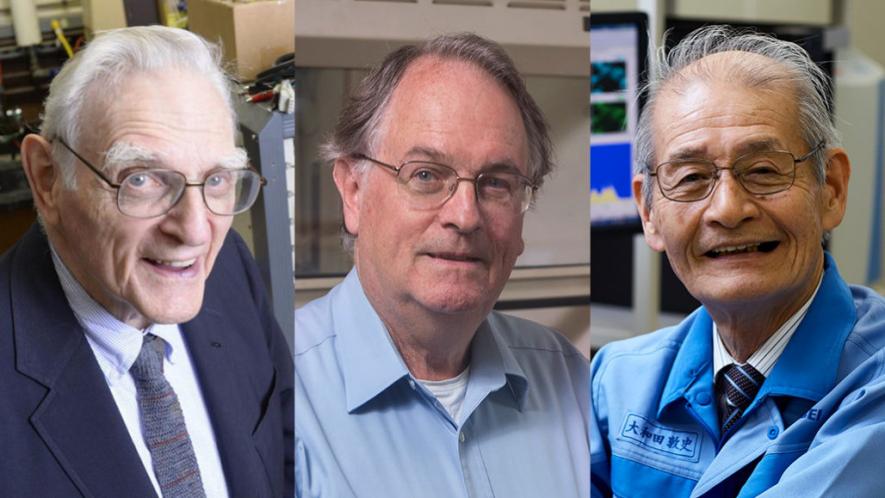Chemistry Nobel Prize Goes to Inventors of Lithium-ion Batteries

Image Courtesy : Sciencenews.org
The lithium ion battery, that has become an indispensable part of our daily lives, brought the Nobel Prize in Chemistry for the year 2019. John B Goodenough, M Stanley Whittingham and Akira Yoshino have jointly shared the prize for their work in discovering the battery that can now be found in almost every home. Larger versions of the battery are thought to be capable enough to charge electric for long trips, while smaller versions are used in life-saving device like cardiac defibrillators.
The work by these three scientists in 1970s and 80s led to the creation of this battery, that has given rise to smooth recharging of nearly all cell phones, laptops, cameras and many other gadgets. At the international space center, astronauts rely on these, and so does renewable engineering.
John B Goodenough, a 97-year-old professor at the University of Texas at Austin, still active in his research, becomes the oldest Nobel prize winner.
Akira Yoshino is an honorary fellow at the Asahi Kasei Corporation and a professor at Meijo
University, Japan.
Stanley Whittingham, Professor at Binghamton University, said that even though he believed that the usage of lithium ion battery will grow, but to see it becoming a part of the daily life was something unimaginable.
Functioning of any device is based upon the supply of energy—as long as energy is provided to the device, it runs. The ability to store energy and use it whenever it is necessary is extremely useful. The need for storing energy and using it as required helped developing the battery technology. In 1800, Alessandro Volta invented the first battery. Volta did this by linking stacks of zinc and copper discs by a cloth soaked in salty water. Then wires were connected to the stacks to complete an electric circuit that produced stable current. Subsequently, this battery was used for running devices like that of telegraphs.
Ever since Volta manufactured the first full battery, scientists have tried to find better ways of electron flow from two electrodes of opposite charges—the anode and the cathode.
Volta’s battery was not a rechargeable one. After half a century after Volta’s invention, came the first rechargeable battery in the year 1859. This primitive rechargeable battery was made up of lead-acid. The problem with the lead-acid batteries is that they are bulky and very heavy. So, the hunt for more portable batteries went on. Nevertheless, the lead-acid batteries are still used to start gasoline and diesel-powered vehicles. More compact batteries made up of nickel-cadmium were built in 1899, but these batteries were less efficient than the earlier ones.
The twentieth century saw no major developments in battery technology until the Arab oil embargo in 1973. The embargo came out as a challenge for scientists, making them look for energy sources other than fossil fuels. Dr. Whittingham, working at Exxon that time, began to search for better technology to store energy from renewable sources so that electric cars could be powered.
Dr. Whittingham realized that lithium can be a good anode as it releases electrons easily. Moreover, lithium’s quality of being the lightest metal also has an edge. He searched for materials that could capture lithium on the opposite electrode, the cathode, and discovered that titanium disulfide can capture lithium ions in small pockets. Titanium disulfide was never used before this in any kind of battery.
“The big advantage of this technology was that lithium-ion stored about 10 times as much energy as lead-acid or 5 times as much as nickel-cadmium. Lithium-ion batteries were also extremely lightweight and required little maintenance. So there was a huge incentive to move to lithium-ion,” said Dr. Whittingham.
But Whittingham’s battery was not free of problems. Repeated charging of his battery led to lithium deposit that could cause short circuit, and even explosions.
Dr. Goodenough, then working at Oxford used cobalt oxide in place of titanium disulfide. Cobalt oxide has a structure similar to that of titanium disulfide, but it freed the lithium battery from lithium deposit and the danger of short circuit. Moreover, this lithium battery also became twice as powerful as the previous one.
The battery technology developed with time and Dr. Akira Yoshino of Japan devised it with more sophistication and showed that carbon-based electrodes can also house lithium in between their layers. With the use of carbon-based electrodes came another good thing, the pure lithium that was used in batteries could be replaced by lithium ions, which are safer.
All these research developments finally led to the large-scale commercialisation of the lithium-ion battery in 1991 by Sony Corporation, the Japanese electronics giant. Because of their compact nature, and being a reliable source, the lithium-ion batteries have become essential to modern electronics.
Get the latest reports & analysis with people's perspective on Protests, movements & deep analytical videos, discussions of the current affairs in your Telegram app. Subscribe to NewsClick's Telegram channel & get Real-Time updates on stories, as they get published on our website.

















